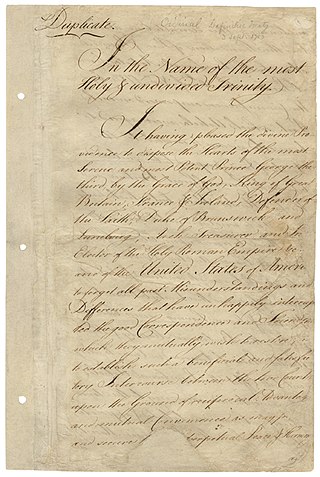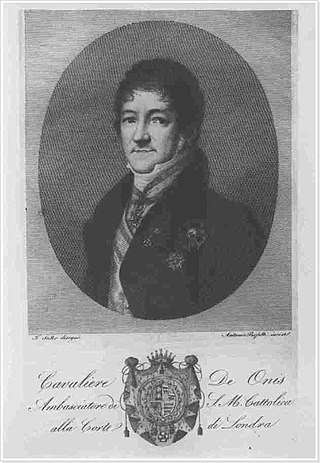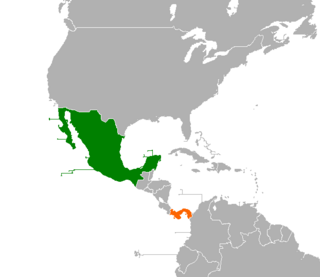
The Treaty of Paris, signed in Paris by representatives of King George III of Great Britain and representatives of the United States on September 3, 1783, officially ended the American Revolutionary War and recognized the Thirteen Colonies, which had been part of colonial British America, to be free, sovereign and independent States.

The Paraguayan War, also known as the War of the Triple Alliance, was a South American war that lasted from 1864 to 1870. It was fought between Paraguay and the Triple Alliance of Argentina, the Empire of Brazil, and Uruguay. It was the deadliest and bloodiest inter-state war in Latin American history. Paraguay sustained large casualties, but the approximate numbers are disputed. Paraguay was forced to cede disputed territory to Argentina and Brazil. The war began in late 1864, as a result of a conflict between Paraguay and Brazil caused by the Uruguayan War. Argentina and Uruguay entered the war against Paraguay in 1865, and it then became known as the "War of the Triple Alliance."

Luis de Onís y González-Vara was a career Spanish diplomat who served as Spanish Envoy to the United States from 1809 to 1819, and is remembered for negotiating the cession of Florida to the US in the Adams–Onís Treaty with United States Secretary of State John Quincy Adams, in 1819.

The Inter-American Treaty of Reciprocal Assistance is an intergovernmental collective security agreement signed in 1947 in Rio de Janeiro among many countries of the Americas.

The Paraguay expedition (1858–1859) was an American diplomatic mission and nineteen-ship squadron ordered by President James Buchanan to South America to demand redress for certain wrongs alleged to have been done by Paraguay, and seize its capital Asunción if it was refused. The expedition was sent without an adequate investigation of the facts; most modern scholars have considered Buchanan's complaints were probably unjustified. The real cause of the misunderstandings was that neither country had employed a competent diplomatic service. Buchanan may have had an ulterior motive, such as to distract public opinion from the domestic concerns that afflicted his presidency, and other sinister explanations were put forward; but possibly Buchanan may have meant to emulate the success of the earlier Perry Expedition, which had "opened up" isolated Japan.

The Moroccan–American Treaty of Peace and Friendship, also known as the Treaty of Marrakesh, was a bilateral agreement signed in 1786 that established diplomatic and commercial relations between the United States and Morocco. It was the first treaty between the U.S. and an Arab, African, and Muslim nation, and initiated what as of 2024 remains the longest unbroken diplomatic relationship in U.S. history.

The Treaty of the Triple Alliance was a treaty that allied the Empire of Brazil, Argentina, and Uruguay against Paraguay. Signed in 1865, after the outbreak of the Paraguayan War, its articles prescribed the allies' actions both during and after the war. The war led to the near-annihilation of Paraguay.

The Treaty of Amity and Commerce established formal diplomatic and commercial relations between the United States and France during the American Revolutionary War. It was signed on February 6, 1778 in Paris, together with its sister agreement, the Treaty of Alliance, and a separate, secret clause allowing Spain and other European nations to join the alliance. These were the first treaties negotiated by the fledgling United States, and the resulting alliance proved pivotal to American victory in the war; the agreements are sometimes collectively known as the Franco-American Alliance or the Treaties of Alliance.

Historically speaking, bilateral relations between the various countries of Latin America and the United States of America have been multifaceted and complex, at times defined by strong regional cooperation and at others filled with economic and political tension and rivalry. Although relations between the U.S. government and most of Latin America were limited prior to the late 1800s, for most of the past century, the United States has unofficially regarded parts of Latin America as within its sphere of influence, and for much of the Cold War (1947–1991), actively vied with the Soviet Union for influence in the Western Hemisphere.

The nations of Mexico and Paraguay established diplomatic relations in 1831. Both countries are full members of the Community of Latin American and Caribbean States, Latin American Integration Association, Organization of American States, Organization of Ibero-American States and the United Nations.

Paraguay–Spain relations are the current and historical relations between Paraguay and Spain. Both nations are members of the Association of Spanish Language Academies and the Organization of Ibero-American States.

The Republic of Texas was a North American nation from 1836 to 1846; in its short time it established diplomatic relations worldwide, mainly through the cotton trade.

The dissolution of the Viceroyalty of the Río de la Plata meant the breakup of the Spanish colony in South America and the creation of new independent countries. Most of the territory of the Spanish viceroyalty is now part of Argentina, and other regions belong to Bolivia, Brazil, Paraguay and Uruguay.

The nations of Mexico and Panama established diplomatic relations in 1904. Both nations are mutual members of the Association of Caribbean States, Community of Latin American and Caribbean States, Latin American Integration Association, Organization of Ibero-American States and the Organization of American States.

The independence of Paraguayde facto started on 14 May 1811 after the Revolution of May 14 when a local ruling junta was created. In early 1811 Paraguayan forces had repeatedly defeated the Argentine army which considered Paraguay to be a break-away province. On 12 October 1813 the Paraguayan Republic was proclaimed. Officially, independence was proclaimed only on 25 November 1842. Paraguayan independence was assured only after the Paraguayan War, when the Empire of Brazil resisted Argentine offers to divide and annex the country.

The sacking of Asunción was the occupation of the Paraguayan capital carried out as of January 1, 1869 by Brazilian forces in the Triple Alliance led by General João de Souza da Fonseca Costa. Asunción was deserted, evacuated by all its inhabitants two days before. On January 5, Luís Alves de Lima e Silva, then Marquis of Caxias, entered the city with the rest of the army. Most of Caxias' army settled in Asunción, where also 4,000 Argentine and 200 Uruguayan troops soon arrived together with about 800 soldiers and officers of the Paraguayan Legion. By this time Caxias was ill and weary of the war. On January 17 he fainted during a mass, relinquished his command on the 18th and left for Montevideo on the 19th.
Relations between the Federal Republic of Central America, also known as the Central American Federation, and the United States were formally established in 1824 following the Federation's independence from Spain. Relations lasted until 1841 when the Federation dissolved and relations with the United States continued among the newly independent former member states of Costa Rica, El Salvador, Guatemala, Honduras, and Nicaragua.
Relations between the Kingdom of the Two Sicilies and the United States date back to 1796 when the U.S. was recognized by the Kingdom of Naples. Relations with the Kingdom continued when Naples reunified with the Kingdom of Sicily which founded the Kingdom of Two Sicilies in 1816. Formal relations were not established until 1832. Diplomatic relations ceased in 1861 when Two Sicilies was incorporated into the Kingdom of Italy.

The Bolivian–Peruvian territorial dispute was a territorial dispute between Bolivia and Peru that lasted from the former's independence in 1825 to the signing of the Polo–Bustamante Treaty in 1909.
















